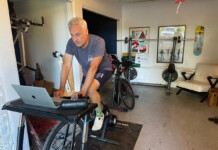By John Cheetham — For most athletes, figuring out what to do when the autumn and winter rain, snow and darkness descend upon us can be challenging. The thought of doing some kind of “base building” ride hour after hour indoors crushes us with boredom and before we know it, laundry starts to get hung on the “ training bike”. The “off-season” slides into the “holiday season” and before we know it we’re stuck in quite a rut. Taking a situation that can be perceived as a negative and viewing the silver lining of free time to try some different things and have fun is key! The off season for me is one of my favorite times of year to recharge with friends and family, check off projects, and plan for the upcoming season.
I enjoy working with athletes from many different climes from Canada to the Bahamas, and I don’t think a “one size fits all “ strategy is that effective or fun. For example, a cyclist living in Utah and the Rockies should be considering cross country and downhill skiing in the winter, while a rider living in a beach town in Southern California might try surfing or stand up paddleboarding, one of my personal favorites.
When searching for off-season activities, consider a two-pronged mental and physical approach. First, we can reap mental benefits from opening our minds to new challenges and keeping things fresh while de-stressing with activities not related to the athlete’s chosen sport.
Second, we can achieve myriad physical benefits by using this off-season time to focus on improving common limiters that can hinder one’s performance. Common limiters such as a lack of flexibility, overall strength, balance, and an insufficient amount of aerobic fitness can be addressed and improved during the fall and winter months.
Everyone Needs Core Work
Core strength is mandatory for increasing every athlete’s performance. Unfortunately core work can often end up taking a back seat to other training during the cycling season. Off-season is a great time to revisit those practices and incorporate them into our daily routines. Core work can benefit non-athletes as well. By maintaining a strong core you can strengthen the muscles that support the spine and pelvis, improving posture and aiding in the ease of common everyday activities. Typically, this can be addressed in season by more of a maintenance approach but much of this work can be mildly fatiguing and take up valuable in season time better spent training for goal events. In the off-season I typically split these activities up into the two focus areas of flexibility and strength, although they sometimes overlap.
Flexibility is Key
Yoga and flexibility is one of my staple activities for every athlete I coach, in season I like them to do a more mellow relaxing version such as Yin or Restorative Yoga (favorite resources I suggest are books and videos by Sage Rountree and Kelly Starrett), but in the off season I encourage them to try the more challenging classes like Bikram, Power or Vinyasa Flow and have some fun with it! Endurance athletes typically have terribly tight hips and hamstrings to start with, and our balance can be a mess!
I like to see a flexibility practice focus on hips and the posterior chain first, then add some torso flexibility with movements we might not normally perform on a bicycle all year. This in a lot of ways is key to all off-season work – do things that are different than your primary sport that will benefit it when you return. Many endurance athletes have a hard time slowing down and struggle with breathing quietly at the end of a session or practice, but they should realize the benefits of the breathing and relaxation practice that not only affect us at rest, but learning to breath truly deeply and calmly even when going hard can have huge rewards.
Time In The Gym
It’s very important to first consider what the goal should be with a strength program, is it building pure strength for track sprinters, building core stability for endurance athletes, perhaps rehab of existing injuries or imbalances? Often we find a combination of several approaches is best for that rider.
A well-designed program should be safe, not create injuries, reach achievable goals, and set the athlete up well for the abuse of the upcoming season.
Especially if an athlete is new to strength training, a sports focused personal trainer can work wonders, really speed up the learning curve, and teach proper form. Find a really good trainer and book an introductory session, see what you think , and go from there.
Trail Running
Switching to running in the winter has a ton of benefits, from shorter more time efficient workouts to increasing bone density and balance skills. You also can often see things in a different light not moving at 20 mph on a bike, with the same old trails taking on a whole new perspective.
The most important consideration for cyclists is the same awesome aerobic engine that we’ve developed riding all those hours can encourage us to run too hard and too long when we start up. All the supple muscles and connective tissues that are accustomed to low impact cycling need time to get used to high impact loads, especially in the lower extremities.
Changing quality shoes very frequently, running on dirt trails, and restraining yourself to very short easy sessions at first will get you up to speed safely. I like to have athletes start with 10 minute runs the first week, and really listen to their bodies. Hobbling around for a week or worse because you cracked off a race pace 10k out of the gate won’t help you achieve your long term goals, so really be conservative.
Watersports
Swimming, surfing, or paddle boarding are utterly challenging for most endurance athletes due to their general lack of upper body muscle mass. On the positive side this can be exactly the break from the bike that cyclists need. These sports can be great for lengthening the body out and learning to control the breathing under stress when inevitably getting submerged or splashed in the face with water. Often I like to have racers in extremely cold climates do a gym day finishing off with a 20 minute swim indoors.
Cross-Country Skiing
Cross-country skiing, like swimming, is a great full-body workout. It not only is an aerobic workout, but also builds upper body strength, balance, and coordination.
Downhill Skiing and Snowboarding
Downhill skiing is like doing weight work, but at high altitude and outdoors. A top to bottom, non-stop run can be an anaerobic workout that makes a great alternative to interval work. Skiing and snowboarding build strength in the legs, as well as core power, balance, and body awareness.
Fat Biking
Fat biking is a fun alternative to summer cycling that will give you a whole new take on your favorite trails. See the article elsewhere in this issue for places to go.
Indoor Cycling Programs
Indoor cycling programs have become quite popular in Utah as well as the rest of the country. They provide a social atmosphere that can keep motivation high when the weather is cold. Additionally, they provide a structured workout and help to maintain fitness when being outside may not be an option due to work constraints or lack of daylight.
Some of the many great indoor programs in Utah include:
- BAM (Balanced Art Multisport)
- Plan 7 House of Watts
- Max Testa Training
- Bike Shoppe
- Elevation Endurance Training
- Contender Bicycles
- Sports Mall
- Treehouse
- LifeTime Fitness
- Train Louder at the Jewish Community Center
- Kinetic Fitness Cycle
- Kickr Lab (part of Salt Lake Triathlon Club)
There’s a ton of different fun options to break up the winter doldrums, stay active, and come into your cycling season recharged, stronger, and faster. Try something new and challenging this winter!
John Cheetham is a USA Cycling Level 1 Coach who has over 20 years of experience as a competitive endurance athlete. Personal achievements include Ironman distance triathlons, marathons, pacing athletes at the Western States 100, and extensive racing in the disciplines of cyclocross, track, and road cycling.








